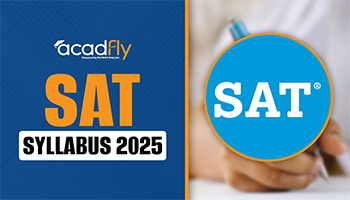
New SAT Format 2025 marks an extreme change in the systematic testing, especially for students aiming for college admissions in the United States and other countries that accept SAT scores. With the College Board officially shifting from the traditional paper-based format to an all-digital version, test-takers in 2025 will be required to adapt to the new exam structure, tools, scoring system, and preparation strategies.
The below section will highlight the aspects of Digital SAT format, including the Digital SAT time breakdown, scoring policies, and how to best use Digital SAT practice tests to score well in the exam:
What is New SAT Format 2025?
New SAT Format 2025 is a new, computer-based version of SAT that is shorter, more flexible, and technologically enhanced. This format has been officially used for all international students since 2023 and for U.S. students starting in 2024, making it the standard format for all students in 2025.
Key Features:
-
Entirely digital, taken via the Bluebook app
-
Shorter test duration: 2 hours 14 minutes
-
Two main sections: Reading & Writing, and Math
-
Adaptive testing modules
-
Built-in calculator for the Math section
-
Faster results: Scores are available within days
Digital SAT Format 2025
The new digital SAT consists of two sections, each with two adaptive modules:
|
Digital SAT Format 2025 |
||||
|---|---|---|---|---|
|
Section |
Number of Modules |
Time per Module |
Total Questions |
Total Time |
|
Reading and Writing |
2 |
32 minutes |
54 |
64 minutes |
|
Math |
2 |
35 minutes |
44 |
70 minutes |
|
Total |
- | - |
98 |
2hr 14 minutes |
Digital SAT Time Breakdown:
-
Reading & Writing: 71 seconds per question
-
Math: 95 seconds per question
What Does Adaptive Testing Mean?
Digital SAT format is adaptive, meaning the difficulty of the second module in each section depends on the candidate's performance in the first module. This helps assess candidates' skill level more precisely in a shorter time.
How it Works:
-
Strong performance in Module 1 unlocks a harder Module 2.
-
Weaker performance in Module 1 results in a moderately difficult Module 2.
-
The candidate's score reflects not just correctness, but also question difficulty.
SAT Marking Scheme per Question
The SAT marking scheme per question remains unchanged in the digital format. The adaptive design doesn’t affect how candidates score directly. It affects which questions candidates get, which in turn shapes their raw score. The points below contain SAT marking scheme per question:
-
+1 point for every correct answer
-
No negative marking for wrong answers
-
Raw scores are converted into scaled scores: 200 to 800 per section, 400 to 1600 total score.
Tools Available in Digital SAT
To make the digital experience smooth and accessible, the College Board has introduced various on-screen tools, including:
-
On-screen calculator (Desmos) for the entire Math section
-
Digital notepad for rough work
-
Annotation tools for highlighting text
-
Question flagging to revisit later
-
Countdown timer with optional warnings
Digital SAT Practice Test Resources
Practice is important for success in the New SAT Format 2025. The College Board provides the Bluebook App, which contains:
-
Full-length adaptive Digital SAT practice tests
-
Familiarisation with the interface
-
Tools similar to the real test
-
Instant feedback and scoring
Best Practice Tips:
-
Take at least 2 full-length digital practice tests
-
Simulate test day environment (no distractions)
-
Focus on pacing due to strict time constraints
Benefits of New SAT Format 2025
SAT changed in 2025 and is now fully digital. It’s shorter, easier to take, and gives results faster. The new format is designed to help students feel less stressed and do better. Below are some key benefits of the New SAT Format 2025:
-
Faster Testing: From 3 hours to 2 hours 14 minutes.
-
More Accurate Scoring: Adaptive modules allow better performance measurement.
-
Student-Friendly Tools: On-screen calculator, flagging, and digital scratchpad.
-
Security & Fairness: Each student gets a slightly different version of the test.
-
Faster Results: Score reports arrive in just a few days, not weeks.
Digital SAT vs Paper SAT: What’s Different?
Digital SAT is a big change from the old paper version. It is shorter, easier to manage, and more personalised. Instead of filling out the answer sheets with a pencil, students now take the test on a computer or tablet. The new format also gives faster results and adapts questions based on their performance. The table below compares the Digital SAT vs the Paper SAT:
|
Digital SAT vs Paper SAT |
||
|---|---|---|
|
Feature |
Digital SAT |
Paper SAT |
|
Mode |
On the computer (Bluebook App) |
Pen and Paper |
|
Duration |
2h 14min |
3 hours |
|
Sections |
2 (Reading/Writing, Math) |
3 (Reading, Writing, Math) |
|
Adaptive Testing |
Yes |
No |
|
Calculator Allowed |
For all Math questions |
Only for one Math section |
|
Result Time |
Within days |
Several weeks |
|
Navigation |
Flag questions, highlight |
Manual skipping only |
Test Day Checklist
Test day can be stressful, but a checklist makes it easier. Knowing what to bring and what to do helps candidates feel ready and confident. Below is are list to help candidates prepare for the Digital SAT and avoid any last-minute problems:
What to Bring:
-
Charged device with Bluebook installed
-
Valid photo ID
-
Pen/pencil and scratch paper
-
Approved calculator (optional)
Test Center Setup:
-
Quiet room with internet
-
Tech support available
-
Desks with power outlets
Preparation Strategy for 2025 Students
Preparing for the Digital SAT in 2025 is different from the old paper test. With the new format, it is important to use updated study methods and tools. Below are step-by-step preparation strategy plan for 2025 students:
-
Understand the Format: Learn about adaptive testing and digital tools
-
Practice Smart: Focus on accuracy and timing in practice tests
-
Review Concepts: Strengthen grammar, comprehension, and math fundamentals
-
Simulate Real Tests: Use the Bluebook app for realistic testing
-
Analyze Mistakes: Improve by learning from wrong answers
New SAT Format 2025 FAQs
What is the duration of the Digital SAT 2025?
Is there a penalty for wrong answers?
Can I use a calculator in the new SAT format?
How are scores calculated in the adaptive SAT?
Where can I take practice tests?









